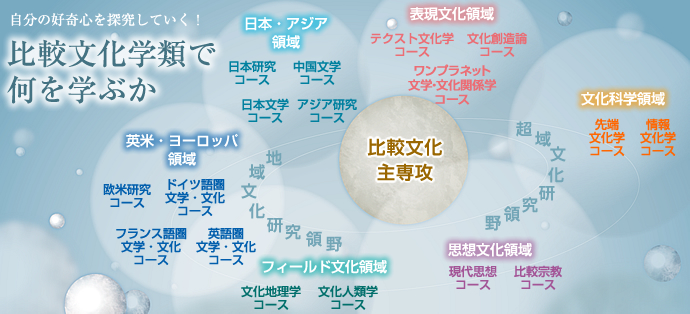6領域17コースについてAbout the 6 Divisions and 17 Areas
学ぶことができる主な学問分野
 |
日本文学、中国文学、英米文学、ドイツ文学、フランス文学、比較文学、文芸学などLiterature: Japanese Literature, Chinese Literature, English and American Literature, German Literature, French Literature, Comparative Literature and Literary Science, etc. |
 |
日本研究、アジア研究、欧米研究などRegional Studies: Japan Studies, Asian Studies, European and American Studies, etc. |
 |
文化地理学、文化人類学、現代思想、比較宗教学などApplied Human Sciences: Cultural Geography, Cultural Anthropology, Modern Thought, Comparative Religion, etc. |
 |
文化地理学、文化人類学、現代思想、比較宗教学などApplied Human Sciences: Cultural Geography, Cultural Anthropology, Modern Thought, Comparative Religion, etc. |
さらに現代の変化に応じた先進的な諸学問領域
Courses focusing on new developments in all academic areas are offered to keep students up-to-date with the changes occurring in the modern society.
これらを、閉ざされた専門分野の中でではなく、
柔軟な組織(6領域と17コース)を通じて学修することが特色です。
These classes are not part of a closed and narrow academic field, but are part of the flexible organization (six divisions and seventeen areas) characterizing the unique study opportunities provided by the College of Comparative Culture. This organization consists of six divisions of academic disciplines divided into seventeen areas of concentration.

※上記各コース名をクリックすると詳細にリンクします。
*Click on any of the above areas for further information.

比較文化学類では、次のような教育目的・目標を掲げています。
The goals and purpose of an education at the College of Comparative Culture are given below.
人類が築いてきた様々な文化を、「現代性」と「学際性」という視点から捉え直し、それを通じて、グローバル化した社会・文化に関わる、広い視野と柔軟な発想力を備えた人材を育成します。さらに、外国語習得を通じた国際的コミュニケーション能力を高めることに努めます。
The College of Comparative Culture strives to provide an education focusing on an approach that reconsiders the diversity of culture created by humanity from a viewpoint of modernity and interdisciplinary studies.
Through this approach, the College of Comparative Culture aims to cultivate individuals capable of having a broad view and a flexible imagination in this global society and culture. Furthermore, the College of Comparative Culture endeavors to improve the international communications skills of students by emphasizing foreign language acquisition to a competent level.
この大きな目的・目標を実現するために、比較文化学類のカリキュラムは6つの研究領域に分かれ、さらに、それぞれの領域にはコースがあり、合計で17のコースがあります。
In order to achieve the goals and purpose outlined above, the College of Comparative Culture divided the curriculum into a total of seventeen areas falling under six divisions.
「領域」は、狭い学問分野にとらわれない広い視野をもって、それぞれの学問分野を横断して学修できるように学際的な性質をもって作られています。
「コース」は、3年生になってから皆さんが最終的に所属する基礎単位で、コースの先生と一緒に卒業論文を仕上げることになります。
In the College of Comparative Culture, the divisions do not mean to be bound to a narrow field of endeavor, but rather indulging in research from a broad interdisciplinary perspective.
The areas are determined in the third year and students will work on their graduation thesis together with the professor.
ただ、どこの「領域」/「コース」に属していても、比較文化学類のカリキュラムは、皆さんの関心や興味にあって様々な授業科目が自由に履修できるように作られています。さらに、興味や将来の志望にあった学修をガイドするために履修モデルを用意して、皆さんの学修にふさわしいカリキュラムを作れるようにサポートします。
However, no matter what division or area a student belongs to, the curriculum of the College of Comparative Culture is designed so that students may choose freely and enroll in, in accordance with their interests, any of the diverse class subjects offered. Furthermore, to provide additional support, a basic curriculum model has been designed so that each student, in accordance with their academic interests and desired field of research or employment after graduation, can design a curriculum that suits their needs.
地域文化研究領野 Regional Culture Studies
日本・アジア領域 Division of Japanese and Asian Studies
日本とアジアにおける文化の諸相を文学・歴史・宗教・社会などに着目しながら体系的に学ぶ。
The Division of Japanese and Asian Studies offers systematic areas of concentration in the cultural aspects of Asia and Japan focusing on literature, history, religion and society.
英米・ヨーロッパ領域 Division of Anglo-American and European Studies
英語圏・ドイツ語圏・フランス語圏に加え、広く欧米の地域文化圏を対象に、文学・言語・歴史・宗教・社会などに着目しながら体系的に学ぶ。
The Division of Anglo-American and European Studies offers systematic areas of concentration in the English, German and French-speaking countries; in a broad sense the regional cultures of the West from literature, language, history, religion to society, are the subject of study.
フィールド文化領域 Division of Field Studies
日本・世界における地域文化の多様性をフィールドワークによって明らかにし、人間と場所のかかわりを通して「人間とは何か」を体系的に学ぶ。
The Division of Field Studies emphasizes fieldwork to bring to light the diversity of regional cultures in Japan and the world providing a systematic study on the relationship between people and place focusing on the nature of humanity.
超域文化研究領野 Interdisciplinary Cultural Studies
表現文化領域 Division of Cultural Expression
地域の限定を越えた文学や、多様な大衆文化、美術・映像・音楽などの表象文化といった人間の表現文化を広く探求する。
The Division of Cultural Expression is a broad field of study consisting of literature and diverse popular culture, including art, film and music, as cultural representation of the human expression of culture that transcends regional limitation.
文化科学領域 Division of Cultural and Social Sciences
生命・身体文化、メディア、ジャーナリズムなどをキーワードに、人間社会の諸問題について複合的な視点から探究する。
The Division of Cultural and Social Sciences focuses on life and physical culture. Key words are media and journalism. A composite perspective is adopted to study the problems of human society.
思想文化領域 Division of Philosophy and Religious Studies
思考・認識・言語・論理・倫理・宗教などをキーワードにして、哲学と宗教を体系的に学ぶ。
The Division of Philosophy and Religious Studies offers areas of concentration in which key words such as thought, cognizance, language, logic, ethics and religion are applied to the systematic study of philosophy and religion.
- 2014年5月28日
- 印刷する